Translational strategies exploiting TNF-alpha that sensitize tumors to radiation therapy
- PMID: 18974777
- PMCID: PMC5705082
- DOI: 10.1038/cgt.2008.86
Translational strategies exploiting TNF-alpha that sensitize tumors to radiation therapy
Abstract
TNFerade is a radioinducible adenoviral vector expressing tumor necrosis factor-alpha (TNF-alpha) (Ad.Egr-TNF) currently in a phase III trial for inoperable pancreatic cancer. We studied B16-F1 melanoma tumors in TNF receptor wild-type (C57BL/6) and deficient (TNFR1,2-/- and TNFR1-/-) mice. Ad.Egr-TNF+IR inhibited tumor growth compared with IR in C57BL/6 but not in receptor-deficient mice. Tumors resistant to TNF-alpha were also sensitive to Ad.Egr-TNF+IR in C57BL/6 mice. Ad.Egr-TNF+IR produced an increase in tumor-associated endothelial cell apoptosis not observed in receptor-deficient animals. Also, B16-F1 tumors in mice with germline deletions of TNFR1,2, TNFR1 or TNF-alpha, or in mice receiving anti-TNF-alpha exhibited radiosensitivity. These results show that tumor-associated endothelium is the principal target for Ad.Egr-TNF radiosensitization and implicate TNF-alpha signaling in tumor radiosensitivity.
Figures
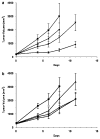
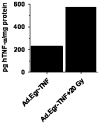

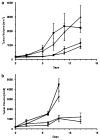
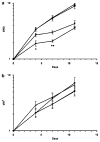
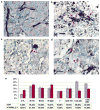
Similar articles
-
Etanercept attenuates the development of cerulein-induced acute pancreatitis in mice: a comparison with TNF-alpha genetic deletion.Shock. 2007 May;27(5):542-51. doi: 10.1097/01.shk.0000246900.50445.1d. Shock. 2007. PMID: 17438460
-
Adenovirally delivered tumor necrosis factor-alpha improves the antiglioma efficacy of concomitant radiation and temozolomide therapy.Clin Cancer Res. 2007 Oct 15;13(20):6217-23. doi: 10.1158/1078-0432.CCR-07-1421. Clin Cancer Res. 2007. PMID: 17947489
-
Blockade of tumor necrosis factor alpha signaling in tumor-associated macrophages as a radiosensitizing strategy.Cancer Res. 2010 Feb 15;70(4):1534-43. doi: 10.1158/0008-5472.CAN-09-2995. Epub 2010 Feb 9. Cancer Res. 2010. PMID: 20145121 Free PMC article.
-
Evoked pain behavior and spinal glia activation is dependent on tumor necrosis factor receptor 1 and 2 in a mouse model of bone cancer pain.Neuroscience. 2010 Aug 11;169(1):463-74. doi: 10.1016/j.neuroscience.2010.04.022. Epub 2010 Apr 24. Neuroscience. 2010. PMID: 20417692
-
Radiation therapy: activation for gene transcription and the development of genetic radiotherapy-therapeutic strategies in oncology.Cancer Biol Ther. 2003 Jul-Aug;2(4):326-9. doi: 10.4161/cbt.2.4.495. Cancer Biol Ther. 2003. PMID: 14508100 Review.
Cited by
-
Efficacy of pEgr-1-endostatin combined with ionizing radiation on hypoxic conditions in nude mice bearing SKOV3 ovarian carcinoma.Oncol Lett. 2017 Mar;13(3):1101-1108. doi: 10.3892/ol.2017.5559. Epub 2017 Jan 2. Oncol Lett. 2017. PMID: 28454220 Free PMC article.
-
Tumour necrosis factor and cancer.Nat Rev Cancer. 2009 May;9(5):361-71. doi: 10.1038/nrc2628. Epub 2009 Apr 3. Nat Rev Cancer. 2009. PMID: 19343034 Review.
-
STAT1 pathway mediates amplification of metastatic potential and resistance to therapy.PLoS One. 2009 Jun 8;4(6):e5821. doi: 10.1371/journal.pone.0005821. PLoS One. 2009. PMID: 19503789 Free PMC article.
-
The role of radiotherapy in locally advanced pancreatic carcinoma.Nat Rev Gastroenterol Hepatol. 2010 Aug;7(8):437-47. doi: 10.1038/nrgastro.2010.98. Epub 2010 Jul 13. Nat Rev Gastroenterol Hepatol. 2010. PMID: 20628346 Review.
-
A phase I dose escalation study of Ad GV.EGR.TNF.11D (TNFerade™ Biologic) with concurrent chemoradiotherapy in patients with recurrent head and neck cancer undergoing reirradiation.Ann Oncol. 2013 Mar;24(3):769-76. doi: 10.1093/annonc/mds523. Epub 2012 Oct 26. Ann Oncol. 2013. PMID: 23104721 Free PMC article. Clinical Trial.
References
-
- Ogawa K, Boucher Y, Kashiwagi S, Fukumura D, Chen D, Gerweck LE. Influence of tumor cell and stroma sensitivity on tumor response to radiation. Cancer Res. 2007;67:4016–4021. - PubMed
-
- Garcia-Barros M, Paris F, Cordon-Cardo C, Lyden D, Rafii S, Haimovitz-Friedman A, et al. Tumor response to radiotherapy regulated by endothelial cell apoptosis. Science. 2003;300:1155–1159. - PubMed
-
- Moeller BJ, Dreher MR, Rabbani ZN, Schroeder T, Cao Y, Li CY, et al. Pleiotropic effects of HIF-1 blockade on tumor radiosensitivity. Cancer Cell. 2005;8:99–110. - PubMed
-
- Gerweck LE, Vijayappa S, Kurimasa A, Ogawa K, Chen DJ. Tumor cell radiosensitivity is a major determinant of tumor response to radiation. Cancer Res. 2006;66:8352–8355. - PubMed
-
- Suit HD, Willers H. Comment on ‘Tumor response to radiotherapy regulated by endothelial cell apoptosis’ (I) Science. 2003;302:1894. author reply 1894. - PubMed
Publication types
MeSH terms
Substances
Grants and funding
LinkOut - more resources
Full Text Sources
Other Literature Sources
Medical

